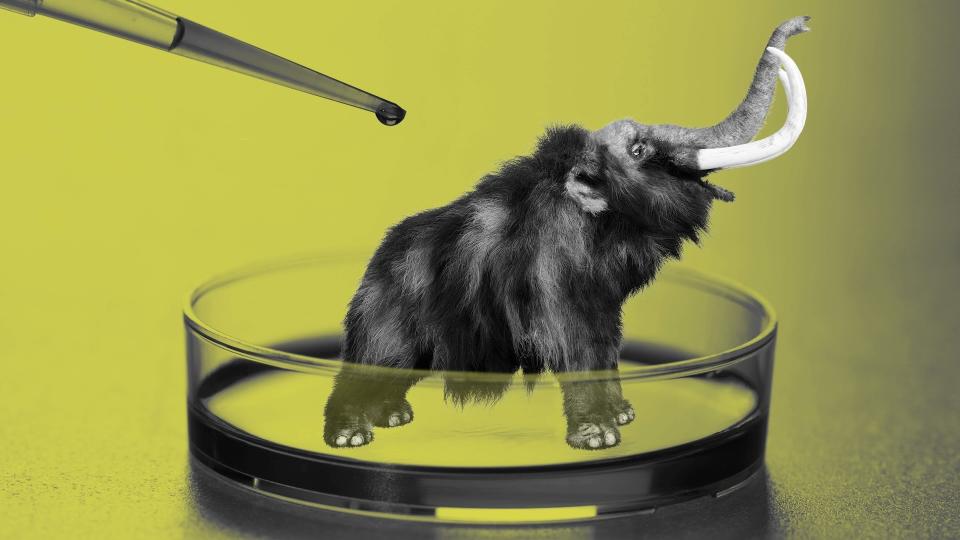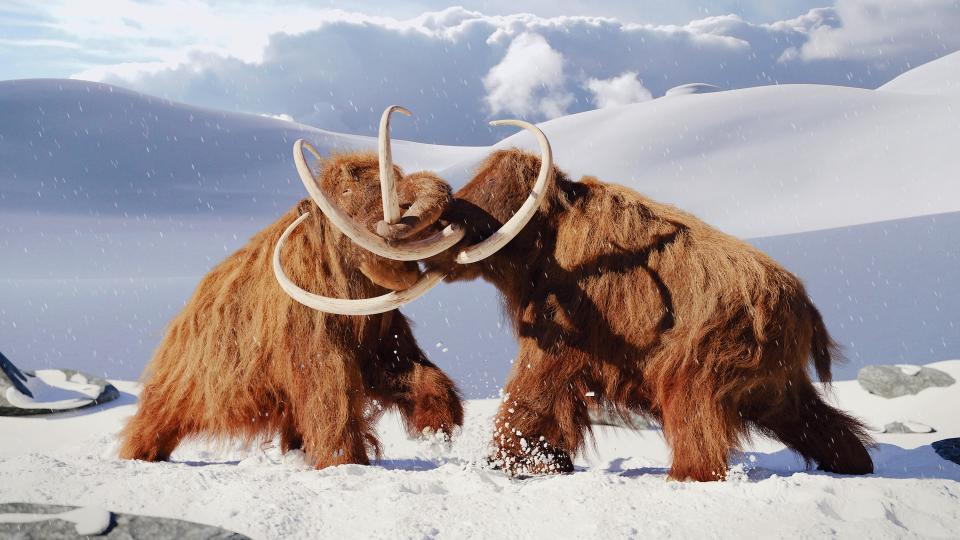When you buy through links on our articles, Future and its syndication partners may earn a commission.

For about seven minutes in 2003, scientists reversed extinction.
The resurrected lineage was the Pyrenean ibex (Capra pyrenaica pyrenaica), and the last known member of the subspecies, a female named Celia, had died three years earlier.
Scientists had collected DNA from Celia’s ear before her death and injected her genetic material into a domesticated goat egg cell with its nucleus removed. The resulting clone — the first and only extinct creature to have been revived at the time — died soon after birth due to a lung defect.
Although that effort failed to produce a healthy animal, “de-extinction” science has advanced dramatically in the past two decades. Technology is no longer a significant hurdle to reviving recently extinct species, and in many cases, we have enough DNA to piece together functional genomes for cloning. The question isn’t so much whether we can resurrect lost species but if we should.
Some companies aren’t waiting to answer that question. For instance, Colossal Biosciences, a Texas-based biotechnology and genetic engineering company, plans to bring back three iconic extinct species: the dodo (Raphus cucullatus), the Tasmanian tiger (Thylacinus cynocephalus; also known as the thylacine) and the woolly mammoth (Mammuthus primigenius). The ultimate goal for these de-extinction efforts, according to Colossal’s website, is to “enrich biodiversity, replenish vital ecological roles and bolster ecosystem resilience.”
But a catastrophic outcome cannot be ruled out, other experts say.
“We have this hubris as humans that we can control our technology,” Oswald Schmitz, a professor of population and community ecology at Yale University, told Live Science. “I’m not so convinced.”
Even in the best-case scenario, conservationists are skeptical that bringing back creatures that died out centuries or millennia ago will offer as much benefit as preserving the ones that are still hanging on.
“What’s gone is gone,” Schmitz said.


Closer than people think
Recent breakthroughs have brought scientists “closer than people think” to reviving long-extinct species, Ben Lamm, co-founder and CEO of Colossal Biosciences, told Live Science. The company aims to produce its first mammoth look-alike calves by 2028, and “it is highly likely that one could see another species before then,” Lamm said, referring to Colossal’s other de-extinction projects.
Woolly mammoths lived in the Arctic between 300,000 and 10,000 years ago. To produce the calves, Colossal scientists will first identify the genes encoding the woolly mammoth’s most emblematic physical traits, such as shaggy hair, curved tusks, fat deposits and a dome-shaped cranium. They will then insert these genes into the genome of closely related, and therefore genetically similar, Asian elephants (Elephas maximus).
“De-extinction” can have different meanings — and our capability for de-extinction depends on how we define it, Love Dalén, a paleogeneticist and professor of evolutionary genomics at Stockholm University, told Live Science in an email. De-extinction in the sense of “creating a form of hybrid species that looks like the extinct one by replacing a limited number of key genes” is possible if there is available DNA from the extinct species, said Dalén, who sits on Colossal’s advisory board. (There is no available DNA from dinosaurs, so creating a Jurassic Park is currently more of a pipe dream.)
Creating an animal that is genetically identical to the extinct species is trickier and depends on the species. For species that went extinct very recently and for which there are high-quality DNA samples, like Celia, “this could be possible,” Dalén said. That’s not the case for mammoths, however.


Dalén and his colleagues have come close to sequencing complete woolly mammoth genomes, but a few regions of DNA, such as some strings of repeat code, still prove challenging.
So far, Colossal Biosciences has acquired more than 60 partial woolly mammoth genomes, which it will use to edit elephant genomes in the lab, Lamm said. Once they have settled on a DNA sequence, Colossal representatives say they will implant a hybrid elephant-mammoth embryo into an Asian or African elephant (Loxodonta) surrogate.
The company also plans to resurrect the dodo and thylacine. “On the dodo project, we have one nearly complete genome,” Lamm said, while on the thylacine, which only went extinct last century, “we’ve got much better genetic data right out of the gate.” For the dodo, Colossal plans to implant the genetic material into domesticated chickens (Gallus domesticus) and, for the thylacine, into mouse-like marsupials called fat-tailed dunnarts (Sminthopsis crassicaudata).
Filling a gap in the ecosystem
The goal of de-extinction is to fill ecological niches that have stood empty since the original species disappeared, said Ronald Goderie, an ecologist and the director of the Taurus Foundation, a branch of Rewilding Europe that aims to create a substitute for extinct aurochs (Bos primigenius). Aurochs, the wild ancestors of domestic cattle (Bos taurus), once roamed across North Africa, Asia and nearly all of Europe. They likely played a vital role in maintaining animal and plant biodiversity through grazing and trampling the soil, according to the Taurus Foundation.
Goderie and his colleagues are bringing aurochs back through back-breeding, which doesn’t involve genetic engineering. Humans hunted aurochs to extinction in 1627, but their DNA lives on in ancient cattle breeds living in Southern Europe, Goderie told Live Science. By selecting and breeding together cattle with physical attributes, behavioral traits and genes similar to those of aurochs, ecologists are inching toward reviving the lost species.
“We’re very close,” Goderie said. “We see very large, steep progress with each generation.”
Woolly mammoths, which thrived during the Pleistocene epoch, maintained Arctic grasslands by trampling the snow, suppressing tree and shrub growth, and dispersing nutrients across huge distances via their dung. Without mammoths and other now-extinct megaherbivores, the so-called “mammoth steppe” has given way to a waterlogged landscape of mossy tundra, shrubs and forest. Research suggests this new landscape stores less carbon than grasslands did and is more susceptible to permafrost thaw. Some scientists have proposed that reintroducing megaherbivores to the Arctic could help restore the ecosystem, boost carbon storage and mitigate climate change.
The dodo was one of the largest terrestrial animals in its ecosystem in Mauritius. Evidence suggests dodos were seed dispersers and thereby influenced vegetation growth — although some experts question the extent to which the birds shaped their ecosystem. Colossal’s plans to reintroduce dodos include ridding Mauritius of invasive species so that the birds can thrive, which the company argues has a beneficial “halo effect” for other species, Lamm said. The company is working with the Mauritian Wildlife Foundation, a non-governmental organization, and intends to partner with the Mauritian government, according to its website.
As for the thylacine, it was Tasmania’s only marsupial apex predator, according to the University of Melbourne’s TIGRR Lab, which is also working on de-extinction. As such, the species was important for predator-prey relationships that stabilized the ecosystem.


Scaling up
But de-extinct species can fulfill their ecological roles only if they survive in the wild and their populations are large enough, Goderie said. In the case of mammoths, that’s a behemoth task.
Researchers recently estimated that Alaska’s vast North Slope could support 48,000 woolly mammoths.
But to fulfill their ecological role — which may include increasing the albedo effect, where snow cools Earth by reflecting light back into space — mammoths would likely need to be reintroduced across the Arctic, said Vincent Lynch, an evolutionary biologist and associate professor at the University at Buffalo.
“You can’t just put them in Alaska and fix the permafrost problem; you have to put them everywhere,” Lynch told Live Science.
There would be like hundreds or thousands of artificial uteruses in a warehouse somewhere, churning out genetically engineered mammoths.
There would need to be several hundred thousand mammoths to have a significant impact on the climate, and that could put living endangered species in peril, Lynch said.
Both Asian and African elephants, which Colossal plans to use as surrogates to grow mammoth calves, are endangered, and every elephant gestating a “mammoth” calf can’t grow babies of its own. “That’s going to reduce population size,” Lynch said.
The alternative would be to implant embryos into artificial wombs, but those have yet to be fully developed. “There would be like hundreds or thousands of artificial uteruses in a warehouse somewhere, churning out genetically engineered mammoths,” Lynch said. “This is like ‘1984’ scary stuff.”
Unintended consequences
In addition to facing technological hurdles, de-extinction could have serious repercussions. For one, de-extinct animals may be sickly, given that the pool of available DNA for each species is relatively small.
Sustaining populations requires a sufficient number of creatures that are genetically different enough to buffer against diseases and harmful mutations.
It’s also worth considering who would be liable if large-scale mammoth reintroductions went wrong. “The ecosystem has been adapting to the absence of mammoths since mammoths started going extinct,” Lynch said. “What if there’s an unintended consequence and something bad happens?”
Other experts echoed these concerns. “To get some impact, you need to have a lot of animals,” Sophie Monsarrat, an ecologist and the rewilding manager at Rewilding Europe, told Live Science.
Reintroductions can lead to clashes between humans and wildlife. “In Africa, if you look at elephant conservation and reintroductions, then there are conflicts,” Monsarrat said. In Kenya alone, human-elephant conflicts killed 200 people between 2010 and 2017, according to WWF. If scientists were to succeed in creating a viable mammoth population, they would have to roll out continent-wide education programs “teaching people how to react in front of a mammoth,” Monsarrat said.
RELATED STORIES
—6 extinct species that scientists could bring back to life
—1st Americans impaled and killed mammoths with pikes, not spears, study suggests
—Ancient chromosomes from woolly mammoth discovered in 52,000-year-old freeze-dried skin
The makeup of the reintroduced population matters too, Schmitz said. Brown bears (Ursus arctos) that were brought from Slovenia to the Italian Alps in the 2000s are thriving, but it turns out that the source population was particularly aggressive, Schmitz said. Ecologists “didn’t necessarily do their homework,” he said. “They reintroduced them, and now they’re attacking livestock and people.”
There’s also no guarantee that animals will stay where we release them, Schmitz said. In 1995, gray wolves (Canis lupus) were reintroduced to Yellowstone National Park but have roamed far beyond the park’s boundaries. “If you unleash something in nature, these animals are going to find places that are the most suitable for them and may not be the places where you think they will stay,” Schmitz said.
And although megaherbivores helped with carbon storage during the last ice age, “restoring megafauna may just as well have a negative impact on climate change,” Dalén said. For instance, mammoths could theoretically contribute to global warming by eroding the permafrost during the warm season and by emitting methane, he said. They could also reduce the amount of carbon stored in woody plants, as elephants do when they eat plants in African savannas.
“A pet project of billionaires”


While proponents think de-extinction is a valuable conservation tool, critics say money would be better spent on existing initiatives. Colossal Biosciences has raised at least $225 million to fund its de-extinction programs, with some of that money also going toward conservation and genetic research across the globe, Lamm said.
Instead of using that money to bring back three extinct species whose ecological impact is unknown, the funds could be put toward saving roughly 100 species that are currently facing an uncertain future, Schmitz said.
In some cases, de-extinction targets species with a living equivalent fulfilling similar ecological functions. For example, one reason the thylacine went extinct was that people perceived it as a predator of livestock, Schmitz said. “But we have a similar animal right now that’s facing similar persecution, and that’s the dingo [Canis lupus dingo],” he said.
Lynch agreed that the best way to support conservation is to spend money on existing, proven initiatives. It’s probably impossible to introduce an ecologically significant number of de-extinct species, which also raises questions about the purpose of de-extinction companies like Colossal, he said.
Adam Searle, a research fellow in cultural, historical and environmental geography at the University of Nottingham in the U.K., said de-extinction is unlikely to contribute to solving the ecological crisis. “It’s literally a pet project of billionaires,” he said.
In response to Searle’s comments, Lamm told Live Science in an email that “for every de-extinction target, the technology and techniques developed will benefit closely related species.” He further argued that “technological innovations made and funded by private sector companies are vital to this fight.”
Regardless of Colossal’s ecological impact, the company could still see a big return on investment, Lynch said.
“If they’re successful — and I have no doubt that they will be — they’re going to make a ton of money,” he said.
For the rest of us and for nature, however, de-extinction “could do a lot more harm than good,” Schmitz said.
Source Agencies



